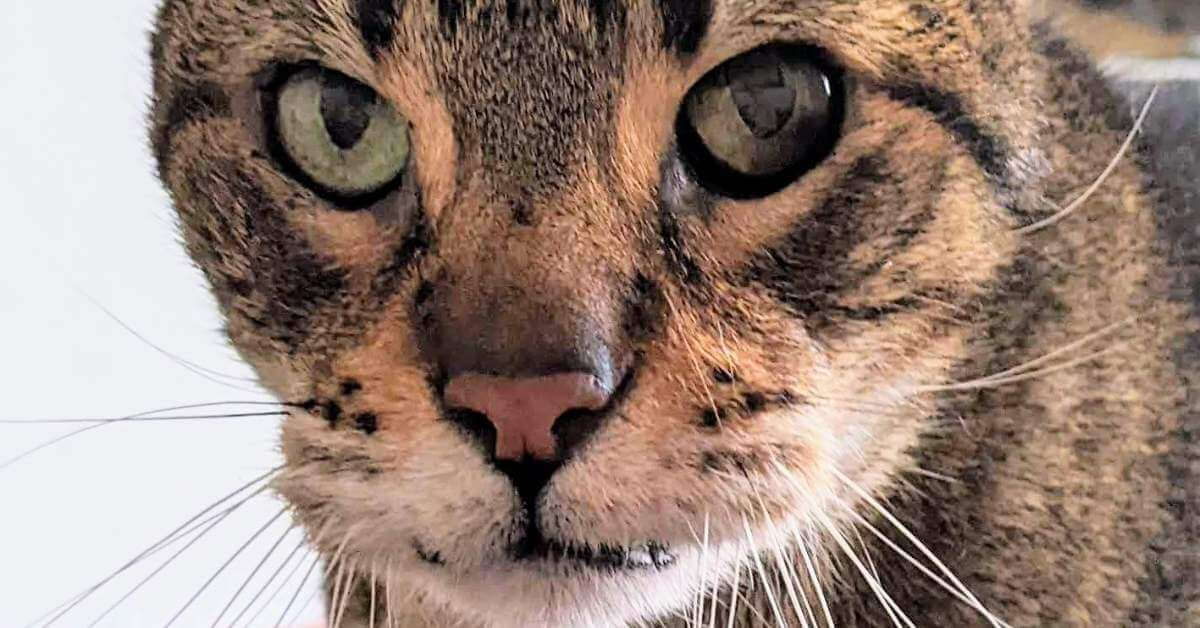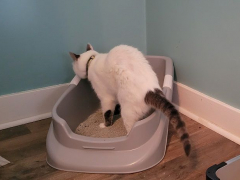
Example of a melanoma in the iris of a cat’s eye, notice how the pupil in this eye is bigger to the other eye. Kayleigh Cook
Melanoma is a type of tumor that is thankfully rare in cats. It most often affects the eye but can also develop in the skin, mouth, ears, and rest of the body. While they can be benign, many melanomas are malignant. This means they can spread to other areas of the body and can be aggressive. So like with any tumor in cats, quick diagnosis and treatment are essential to give cats the best chance of recovery.
Quick Overview: Melanoma in Cats
 Common Symptoms: Raised, dark patches or masses on the skin or mouth ; dark spots on iris of eye
Common Symptoms: Raised, dark patches or masses on the skin or mouth ; dark spots on iris of eye
 Requires Ongoing Medication: No
Requires Ongoing Medication: No
 Vaccine Available: Not as preventative, can be used as a form of treatment
Vaccine Available: Not as preventative, can be used as a form of treatment
 Treatment Options: Surgical removal of mass +- radiotherapy or chemotherapy
Treatment Options: Surgical removal of mass +- radiotherapy or chemotherapy
 Home Treatment: Careful monitoring of the mass and treatment of any complications that may develop
Home Treatment: Careful monitoring of the mass and treatment of any complications that may develop
This article will tell you everything you need to know to recognize signs of melanoma in your cat and what to do next.
Cause of Melanoma in Cats
Melanomas form from cells called melanocytes, which generate pigment. Melanocytes are found in many tissues in the body, including skin, hair follicles, and irises (the colored part of the eye). Melanomas occur when these cells become abnormal and replicate rapidly. In people, we know that sun exposure is a common cause of melanomas in the skin. But the same link hasn’t been found in cats.
Currently, we don’t know exactly what causes melanoma in cats. As melanoma is uncommon in cats, studies often have enough case studies to find conclusive links. But of the research we have so far, we don’t think that any sex or breed of cat is more predisposed to developing melanoma. Other than that, a large-scale review of melanomas in cat’s eyes, saw a slightly higher proportion than expected in Persian cats.
We do know that, like most types of cancer, melanoma is more common in middle-aged to older cats. A recent study looking at eye cancer in 2614 cats (of which 67% were melanomas) found a median age of 9.4 years in cats with diffuse iris melanoma. Other smaller studies looking at melanomas outside of the eye in cats have found similar results, although it is important to know that melanomas have been seen in cats as young as two years old.
Symptoms of Melanoma in Cats
The symptoms of melanoma vary, depending on where on your cat’s body it is. In general, wherever it’s found, a melanoma will cause a raised mass that is often dark in color (although this is not always the case). Types of tumors in cats are often hard to distinguish based on their appearance. So, although recognizing the signs of melanoma is helpful, you must take your cat to the veterinarian if you notice any new mass or unusual change.
Symptoms of Ocular (Eye) Melanoma

Benign iris melanosis is common as cats get older and can be difficult to distinguish from melanoma. Barbarajo / Shutterstock.com
Your cat is most likely to be affected by a melanoma in their eye. This is called an ocular melanoma. Ocular melanomas usually first appear as flat, darkened areas on your cat’s iris (the colored part of their eye) or sclera (the white area). As they progress, they can become larger and raised.
In their later stages, they can cause the eye to look abnormal:
- Irregular pupil
- Enlarged eye-ball
- Cloudiness to the surface of the eye
- Redness in the blood vessels around the eye
- Blindness
Occasionally, iris melanomas may look more like large, bulging masses in the eye.
It is important to note here that it is very difficult to distinguish between the early stages of a melanoma in the iris and a benign freckle called iris melanosis. The latter are flat, dark spots in the iris that commonly occur in older cats—a bit like an age spot on the skin in people. They look very similar to melanomas but should not be raised or rough when examined from the side using specialist equipment. If your cat has changes to their iris, they will need to be checked regularly by a veterinary opthalmologist, as it can be difficult to spot the signs of cancer early on.
Symptoms of Cutaneous (Skin) Melanoma
Cutaneous melanomas are found on your cat’s skin. Common places include the ears, head, and toes but they can appear anywhere on your cat’s skin. They can look like anything from a flat, slightly raised area of skin to an obvious lump. As they are made up of cells that produce pigment, they are usually dark in color. But not all dark masses in cats are melanomas. They can look very similar to a benign type of tumor called a basal cell tumor.
Like with all skin lumps in cats, it is hard to tell the benign lesions from the more serious ones. So always get any new change checked by your veterinarian.
Symptoms of Oral (Mouth) Melanoma
Oral melanomas are found in your cat’s mouth. Unfortunately, these types of melanomas are usually very aggressive. They often grow rapidly and cause damage inside the mouth, as well as spreading to other areas of the body.
Signs of oral melanoma can include:
- A visible mass within the mouth
- Smell from the mouth
- Difficulties with eating or swallowing
- Pain opening or closing mouth
- Discharge from the mouth (including blood or pus)
- Weight loss
Complications of Cats With Melanoma

Cats with ocular melanomas often suffer with other complications within the eye as the tumor progresses. Hillary Pearce
Like other types of tumors, it is common for cats with melanomas to suffer complications. This might be because of problems they cause immediately around them, or due to spread (metastasis) to other areas of the body. Malignant melanomas commonly spread to lymph nodes, liver, and lungs.
The type of complications you might see will depend on where your cat’s melanoma is.
Complications in Cats With Ocular Melanomas
Melanomas in the eye are often slow-growing and may not cause a problem for some time. But if they grow in size they can cause a variety of complications within the eye, including:
- Changes to the size of shape of the pupil
- Inability of pupil to enlarge or restrict in response to light
- Blindness or reduced vision
- Glaucoma (a build-up of pressure in the eye)
- Inflammation and discomfort
- Conjunctivitis
- Uveitis
Monitor your cat carefully for any changes to the appearance of their eyes or their vision. In particular, signs of pain (such as redness, closing the eye, light aversion) should be checked immediately.
Complications in Cats With Cutaneous Melanoma
Melanomas on the skin rarely cause issues immediately around them unless they are particularly aggressive or fast-growing. However, if not treated, malignant cutaneous melanomas can spread to other areas of the body causing problems there.
Complications in Cats With Oral Melanoma
Unfortunately, in my experience as a vet, cats with oral tumors like melanoma often suffer from complications. Masses in the mouth tend to grow and cause pain when cats are eating. If they get caught by the teeth they can bleed and become infected. If the melanoma is causing pain or affecting your cat’s ability to eat, it can seriously affect their quality of life.
Diagnosis of Melanoma in Cats

A biopsy of malignant melanoma under the microscope, with the brown color being the melanin pigment sometimes produced by the tumor cells. Melanie Dobromylskyj BSc Vet Path (Hons), BVSc, PhD, FRCPath, FRCVS / Finn Pathologists
Melanomas can display certain recognizable characteristics—such as being dark in color or in a particular place—that may make you or your veterinarian suspicious. However, like with most types of tumors, the only way to be sure is to take a sample. This involves taking either a fine needle aspirate or a biopsy and sending it away to be looked at by a veterinary pathologist.
Taking a sample is usually the first step for suspected melanomas affecting the skin or mouth. However, taking a biopsy from within an cat’s eye is a lot trickier. Whilst this procedure is offered in some specialist hospitals, it’s still uncommon. So the diagnosis of melanomas in the eye is a little different.
If your cat has changes in their iris, they will need to undergo a full ophthalmic examination. This might be best performed by a veterinary ophthalmologist, as they have specialist equipment that can help spot signs of cancer. They can also identify any complications in the eye that the melanomas might be causing, such as increased pressure. As many melanomas in the eye are very slow growing, your cat may need to be checked regularly as very early melanoma can be impossible to distinguish from benign freckles.
Staging of Melanoma

Abdominal ultrasound can be used as part of staging to check for spread in the organs of the abdomen, particularly the liver. fotogenicstudio / Shutterstock.com
If your cat is diagnosed with melanoma on a biopsy (or ophthalmic examination), the next step will be to stage the disease. This is to work out if the cancer has spread to anywhere else in the body and helps determine what their treatment should be. Staging is also vital in giving you a prognosis.
Staging includes:
- Chest x-rays or CT scan of the lungs
- Abdominal ultrasound or CT scan of the abdomen (particularly the liver)
- Sampling of nearby lymph nodes
Survival times for cats with malignant melanoma depends on the staging of the disease, and whether or not the tumor can be removed completely with surgery.
Treatments for Cats With Melanoma
Where possible, surgical removal is the main treatment for cats with melanoma. If the growth is benign or hasn’t shown signs of spreading yet, removal can be curative as long as the tumor is removed with clear margins. In the case of ocular melanoma, this involves the removal of the whole eyeball (enucleation).
Sometimes the tumor may be difficult to remove with cancer-free margins, or there might be evidence of spread to other areas of the body already. If this is the case for your cat, your veterinarian may suggest radiotherapy or chemotherapy – either in addition to or instead of surgery.
Melanoma Vaccine
There is a vaccine available to treat melanoma in dogs. Unlike traditional vaccinations, the melanoma vaccine is designed for dogs already suffering from melanoma, not to prevent it. Called Oncept, it works by stimulating the animal’s immune system to fight against the cancerous melanoma cells. Currently, Oncept is only licensed for dogs with oral melanoma. But some specialists have used it ‘off-license’ for melanomas at different sites, and in different species. A 2017 study looked at the safety of administering the canine melanoma vaccine (Oncept) to cats with malignant melanoma and concluded it could be given safely. Although, this study only included 24 cats, and didn’t look at how effective the treatment was.
The vaccine is currently not widely used in cats and has yet to be studied thoroughly. Even in dogs, its use is controversial in veterinary oncology. However, it is a treatment option that hopefully will offer some benefits to cats suffering from melanoma in the future.
Caring for Cats With Melanoma

There is a lot you can do to help your cat feel comfortable at home after being diagnosed with melanoma. Veera / Shutterstock.com
If your cat has a melanoma removed with tumor-free margins, and no evidence of spread elsewhere in their body, it is likely they will go on to live a normal life. Once they have recovered from surgery, they should not need any extra care. But you should monitor the site of the surgery regularly to check for any signs of recurrence and get any changes in your cat’s health checked promptly.
If surgical removal is not an option for your cat, much of the care they will need will be related to complications of the melanoma. Prognosis in cats with malignant melanoma that has not been removed completely varies widely, from weeks to years.
Caring for Cats With Ocular Melanoma
Cats with ocular melanoma need regular checks with an ophthalmologist to ensure they do not develop serious complications such as glaucoma (increased pressure in the eye). You should monitor them closely for any changes in the appearance of their eye or their vision. If your cat has changes in their vision you may need to make alterations to their lifestyle to keep them safe, such as keeping them indoors.
Caring for Cats With Oral Melanoma
Cats with melanomas in their mouths need careful monitoring to ensure they are not in pain, and they can still eat and drink. You should also check regularly for any smell or discharge from the mass which could indicate an infection. In the short term, cats with symptoms of oral melanomas might benefit from medication such as pain relief or antibiotics.
Palliative Care for Cats With Melanomas
Cats with malignant melanomas usually become unwell because of their condition at some point. This might be because of complications of the mass itself, or because of the effects of spread in the rest of the body.
Palliative (end of life) care may involve certain medications such as pain relief, antibiotics, or anti-sickness medication. But cats also benefit hugely from TLC at home, including
- Somewhere quiet, soft, and warm to rest
- Tasty, soft food that they enjoy
- Easy access to food, water, and litter trays
Remember, your veterinary team is there to support you in caring for your cat and assessing their quality of life. As a veterinarian, I not only ask owners about the basics – such as whether their cat is still eating and drinking, or moving around – but also whether they are still doing the little, quirky, things that make them, them. This can be anything from enjoying a chin rub to greeting you when you come home. One of the most important conversations I have with cat owners is how to know when to say goodbye.
Read More: 11 Signs Your Cat Is Nearing the End of Their Life
Prevention of Melanoma
We don’t currently know the exact cause of melanoma in cats, so it is tricky to prevent. The best way you can help at home is to monitor your cat regularly for any changes and get them checked by a veterinarian as soon as possible. Early diagnosis of melanomas means they are easier to remove and less likely to have spread.
Frequently Asked Questions
What does cancer look like on a cat’s skin?
Skin cancer in cats can take on many forms. From a non-healing wound to a slightly raised or discolored area, or an obvious mass. It can also look very similar to benign skin conditions. So, it is important to get any change in your cat’s skin checked by a veterinarian as soon as possible.
How rare is melanoma in cats?
Melanoma is an uncommon type of cancer in cats. When it is found, it usually affects the eye (ocular melanoma). Ocular melanoma is the most common type of cancer found in cat’s eyes. Melanomas can also affect the skin, mouth, and other parts of the body, but this is less common.
Can cats survive with melanoma?
Surgical removal of melanomas in cats can be curative if the whole tumor is removed, and it has not spread to anywhere else in the body. But without treatment, malignant melanomas will usually go on to cause illness, and eventually death. Prognosis varies from weeks to years, depending on the type of melanoma.
How curable is eye melanoma?
Malignant melanoma of the eye is usually treated by complete removal of the eye – a surgery called enucleation. If the cancer has not spread to anywhere else in the body, this is can be completely curative. If there is evidence of spread, your veterinarian may recommend radiotherapy or chemotherapy as well as surgery.
-
Bergman, P. J. (2020). Melanoma. Clinical Small Animal Internal Medicine, 1347–1352.
-
Patnaik, A. K., & Mooney, S. (1988). Feline melanoma: A Comparative study of ocular, oral, and dermal neoplasms. Veterinary Pathology, 25(2), 105–112.
-
Ocular and Periocular Tumors in cats - WSAVA2011 - VIN. (n.d.).
-
Kayes, D., & Blacklock, B. (2022). Feline Uveal Melanoma Review: Our current understanding and recent research advances. Veterinary Sciences, 9(2), 46.
-
Sarbu, L., Kitchell, B. E., & Bergman, P. J. (2016). Safety of administering the canine melanoma DNA vaccine (Oncept) to cats with malignant melanoma – a retrospective study. Journal of Feline Medicine and Surgery, 19(2), 224–230.
-
Pellin, M. A. (2022). The use of Oncept Melanoma vaccine in veterinary patients: A review of the literature. Veterinary Sciences, 9(11), 597.
-
Featherstone, H., Scurrell, E., Rhodes, M., & De Lacerda, R. P. (2019). Iris biopsy to investigate feline iris hyperpigmentation. Veterinary Ophthalmology, 23(2), 269–276.







